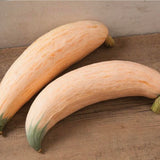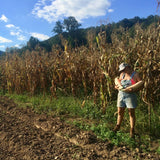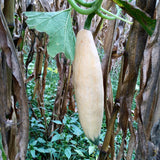North Georgia Candy Roaster Squash
Cucurbita maxima
Sweet and dense Appalachian heirloom winter squash bred by the Cherokee Nation in the 1800s. Great for pies and roasting on the half shell. Long, pink, banana-shaped fruits with blue tips. Grower Chelsea Askew says this is by far her favorite squash for is thick, creamy flesh that not watery and is perfect for sweet or savory dishes. She grows this crop amongst her corn plants where the vines cover the soil and occasionally climb the stalks.
Slow Food USA includes this variety in its "Ark of Taste". Thank you to Chelsea Askew for growing these seeds and sharing her photos. The primary photo here was shared with us by Slow Food Charleston.
Days to maturity: 100
Seeds per pack: 17
Germination rate: 85% on 1/10/2024
Planting / harvesting notes
Direct sow in warm soil after the last frost, or seed indoors 2-3 weeks beforehand and transplant. Plant 3 seeds per hill spaced several feet apart, or seed in rows, one plant every 2-3 feet. Vines grow at least 10' if not much longer, so allow them space to sprawl. If grown in corn, you may need to train them so they won't pull it down! Avoid downy mildew by watering only at the base of the plant (not on the leaves!). Harvest when the stem begins to turn brown and woody and the fruit becomes hard, leaving a couple/few inches of stem. Cure in a dry or sunny place for a week, and then store in a cool (45-50 degrees) room for up to 5 months (however, keep an eye on it and use it at earliest sign of softening if not before).
Seed keeping notes
Squash is insect pollinated and requires about 1/2 a mile of isolation from other varieties of the same species, which in this case is C. maxima. The seeds will be fully mature on any squash when the stem of the fruit has turned brown and woody, so when you eat your squash, the seeds should also be ready for harvest. Separate the seeds from the flesh, rinse them, and dry them on a screen or paper product away from direct sunlight in a ventilated place. The plumpest and hardest seeds will be most viable.









